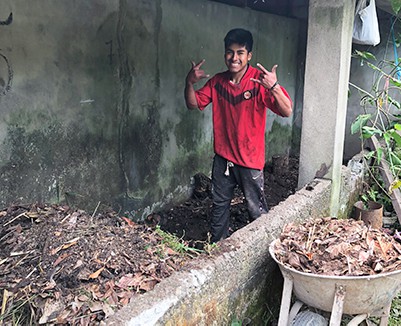by Penny Livingston Stark, Co-Founder, Regenerative Design Institute
At long last I have been able to travel home from a 10-month sojourn in Peru. I was called to the Sacred Valley in March of 2020 to work with local farmers, helping to support them in returning to organic agriculture. So much had been forgotten due to deep-rooted colonization. Many farmers simply didn´t believe corn could be grown organically. We proved it to them by growing a stunning crop of “Choklo”–a large-seeded variety and a favorite of the locals. This created more interest within the community to learn about organic agriculture.
Due to the pandemic, the Peruvian government issued controls on travel. Because of the lack of capacity to travel, the farmers selling their produce locally became essential while the farmers selling crops for export suffered since they could not get their produce to out-of-region markets. Inter-district travel was banned, so there was no travel allowed for months between Lima and Cusco. There was no mail delivery for months. There was no bus travel and no taxis allowed. So local walking-distance travel was the only way to get food, pay bills, etc.
Looking back on my almost-year in Peru, I realize that I made a bigger difference there than if had I stayed home. People–both local and expats–were hungry for knowledge in learning how to start seeds and grow food. Learning how to feed plants using compost, vermiculture, and various concoctions of micro-organisms was a growing interest among the community. So I was quite busy during most of my time in Peru.

Many local Quechua people are against any kind of NGO or aide work. If help is coming from an outside NGO, there is a lot of suspicion and mistrust. If help comes from the community it’s ok, and I was considered a community member as I was basically living there. This mistrust is understandable, because NGOs often use local indigenous people as opportunities to raise money, without bringing the money back into the community. At the same time, these people do not want to be perceived as poor, desperate people in need of rescuing. And that image is very far from the truth. They are a strong people full of resilience, fully capable of helping themselves and each other.
This pandemic has spawned a renewed look at what skills they need to develop and how to re-instate some of their old trade routes and supply lines that worked for centuries. I was not aware until a local elder told me that there had been an agricultural revolution in Peru that lasted for 30 years from the early 1940s until the early 1970s. The people succeeded in overthrowing the big haciendas who were controlling the people by withholding land and water. When the victory occurred in the 1970s, people finally got access to their land again. At that time, the “Green Revolution” was in full throes with chemical fertilizer and pesticide companies funding the agriculture programs in the universities as well as going into the countryside “teaching” all of the farmers how to grow food with this new agriculture system. This story is told all over the world: how governments and universities pressured farmers to adopt these modern practices, telling them that they they were superior to their traditional “backward” ways. The rest is history, as the global south adopted chemical mechanized agriculture.
It’s been an honor and priviledge to be invited into these farming communities with farmers eager to understand plant physiology and soil biology and composting, which were the main topics I focused on. Seeds are planted now and organic agriculture is taking a hold in the Sacred Valley, in the high jungles of Peru, and other places as new farms are being planted and farmers are now sharing knowledge among themselves. They understand that nutrition in their food starts with healthy soil.
I look forward to going back for another visit in the future when travel is easier and there is not a rampant global pandemic. The community there is full of heart and the people are so friendly and kind. My memories of my time there are filled with their beautiful music, the scent of their amazing Peruvian food, and the colorful dress of the locals. The land is full of prayers and sacred sites are everywhere.
While I was there in Peru, we also launched a live, on-line Permaculture Design Course with an online school called Ecoversity. We launched last April and capped it at 200 people. We have a 950 person waiting list! We are starting our second cohort this February, and I’ll be teaching from our home on Whidbey Island. You can find out more about the course on their website: www.ecoversity.org
To be honest, I was totally surprised at how successful this has become. Online classes offer various advantages. Our first cohort had people from 27 different countries attending and offering mulit-cultural perspectives. People can communicate with the class and other students in real time using the chat. We have breakout groups for students to connect and discuss issues with each other and we can have international teachers come as guests.
I´m very happy to be home on Whidbey Island. A place a majestic beauty, home of Eagle and Orca.
You can stay connected with me through my website: www.pennylivingston.net.
